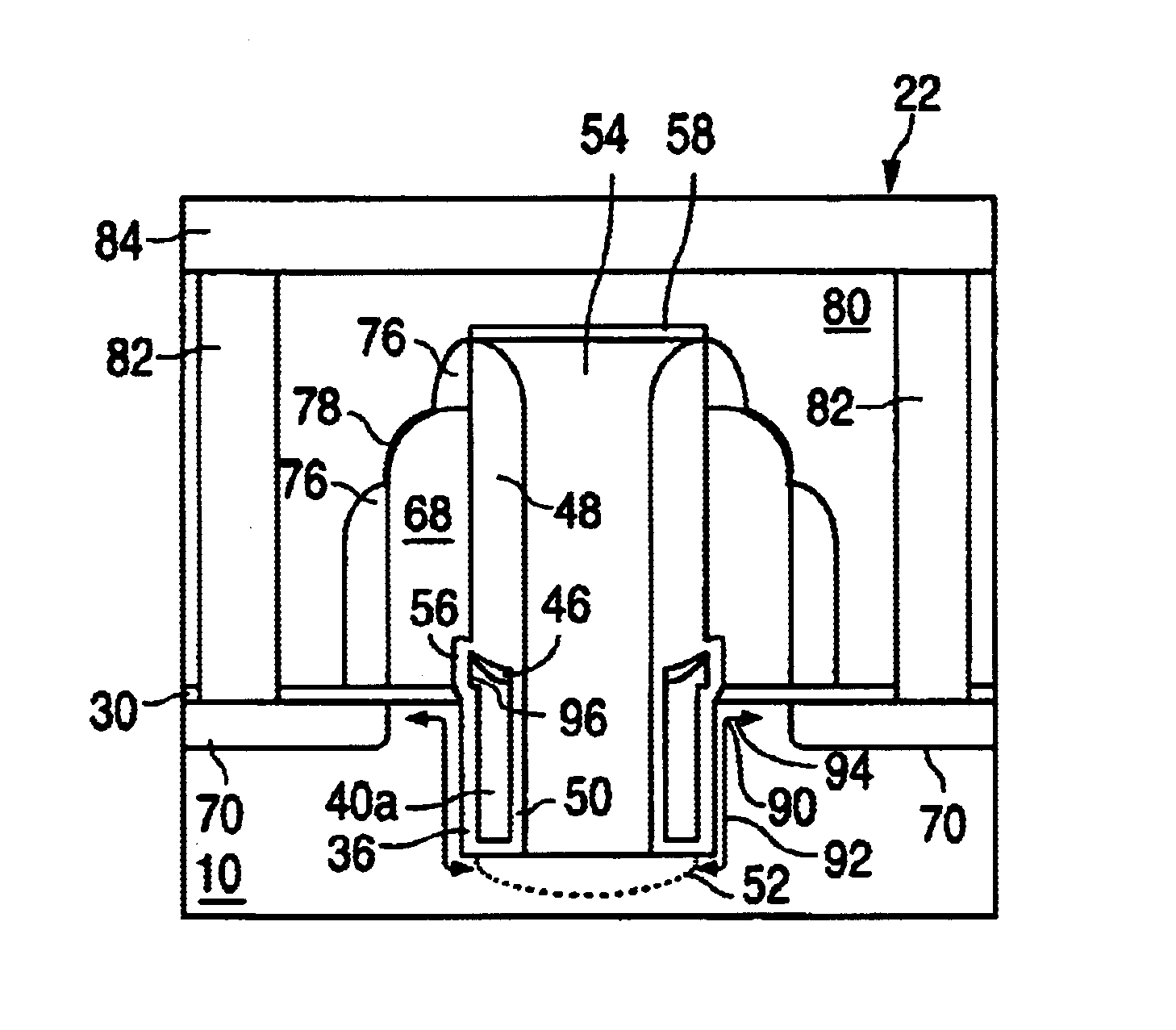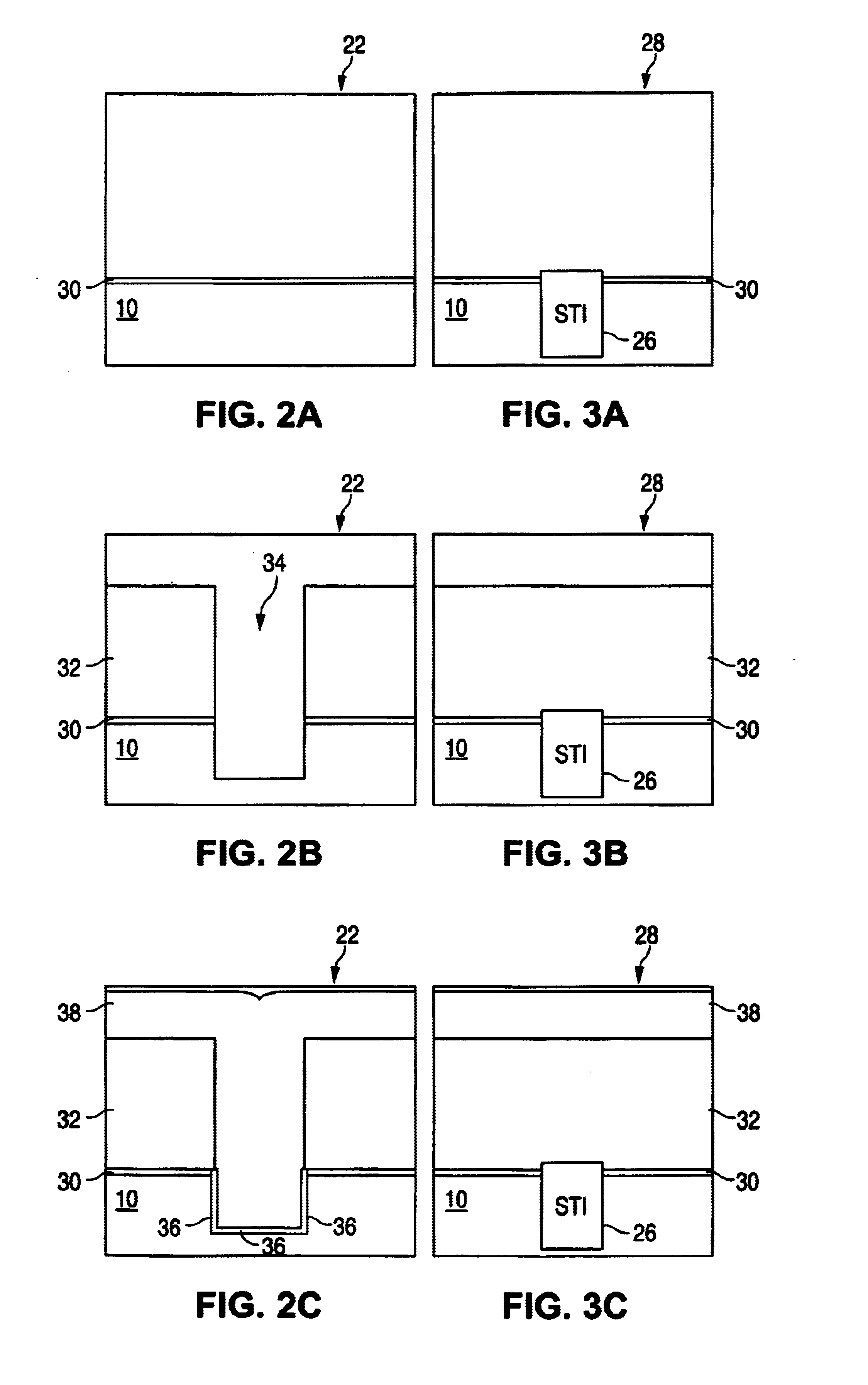Semiconductor memory array of floating gate memory cells with buried source line and floating gate
a memory cell and memory array technology, applied in the direction of semiconductor devices, electrical devices, transistors, etc., can solve the problems of reducing the efficiency and reliability reducing the efficiency of the operation of the memory cell, so as to achieve the necessary operational parameters for efficient and reliable operation, and reducing the size and formation of the memory cell elements
- Summary
- Abstract
- Description
- Claims
- Application Information
AI Technical Summary
Benefits of technology
Problems solved by technology
Method used
Image
Examples
first alternate embodiment
[0065
[0066]FIGS. 5A to 5J show the cross sections of the structure in the active regions 22 for an alternate method for making the memory cell array of the present invention. This first alternate process starts with the structure shown in FIG. 2A. For simplicity, elements in common with the first embodiment described above are designated using the same element numbers.
[0067]The thick nitride layer 32.(e.g. ˜1000 to 10,000 Å in thickness) is formed over oxide layer 30. Parallel second trenches 34 are formed in the nitride layer 32 by applying a photo resist (masking) material on the nitride layer 32, and then performing a masking step to remove the photo resist material from selected parallel stripe regions. An anisotropic nitride etch is used to remove the exposed portions of nitride layer 32 in the stripe regions, leaving second trenches 34 that extend down to and expose oxide layer 30. After the photo resist is removed, oxide spacers 102 are formed in second trenches 34 by an oxid...
second alternate embodiment
[0076
[0077]FIGS. 6A to 6G and 7A to 7G illustrate a second alternate method for making the memory cell array of the present invention. This second alternate process begins with the structures shown in FIGS. 2B and 3B, but without the formation of oxide layer 30 underneath nitride layer 32, as oxide layer 30 is optional for this embodiment. After the formation of insulation material 36 as described above with respect to FIG. 2C, the ion implantation (and possible anneal) process is used to form the first (source) regions 52 in the exposed substrate portions at the bottom of second trenches 34. A thin poly layer 118 is then formed over the structures, as shown in FIGS. 6A and 7A. Poly layer 118 can be doped (e.g. n+) by ion implant, or by an in-situ process. The thickness of poly layer 118 is preferably 50-500 Å, and dictates the eventual thickness of the floating gates for the final memory cell device.
[0078]Oxide is formed over the structure, followed by a planarizing oxide etch (e.g...
third alternate embodiment
[0086
[0087]FIGS. 8A to 8D and 9A to 9D illustrate a third alternate method for making the memory cell array of the present invention. This third alternate process begins with the structures shown in FIGS. 2B and 3B. After the formation of insulation material 36 as described above with respect to FIG. 2C, the ion implantation (and possible anneal) process is used to form the first (source) regions 52 in the exposed substrate portions at the bottom of second trenches 34. Poly spacers 126 are then formed in second trenches 34 by forming a layer of polysilicon over the structure, followed by an anisotropic poly etch that removes the poly layer except for the poly spacers 126, as shown in FIGS. 8A and 9A. The poly spacers preferably have a height no greater than the STI blocks 26 in the isolation regions 24 (e.g. use STI blocks 26 in the inactive regions as an etch stop), which ensures all the polysilicon is removed from the isolation regions.
[0088]Oxide is formed over the structures of ...
PUM
 Login to View More
Login to View More Abstract
Description
Claims
Application Information
 Login to View More
Login to View More - R&D
- Intellectual Property
- Life Sciences
- Materials
- Tech Scout
- Unparalleled Data Quality
- Higher Quality Content
- 60% Fewer Hallucinations
Browse by: Latest US Patents, China's latest patents, Technical Efficacy Thesaurus, Application Domain, Technology Topic, Popular Technical Reports.
© 2025 PatSnap. All rights reserved.Legal|Privacy policy|Modern Slavery Act Transparency Statement|Sitemap|About US| Contact US: help@patsnap.com



